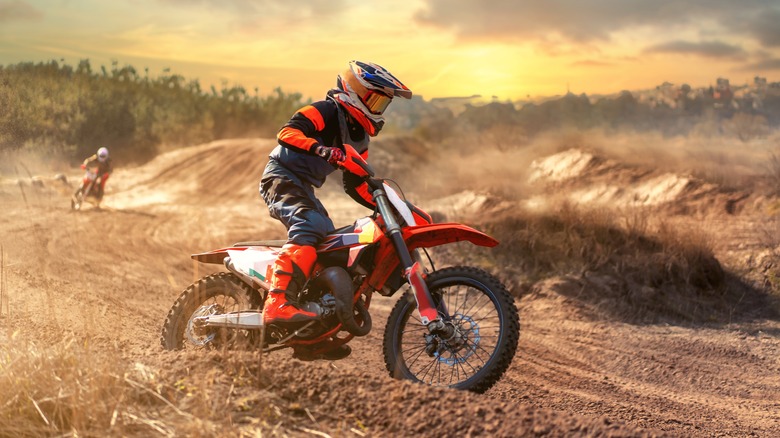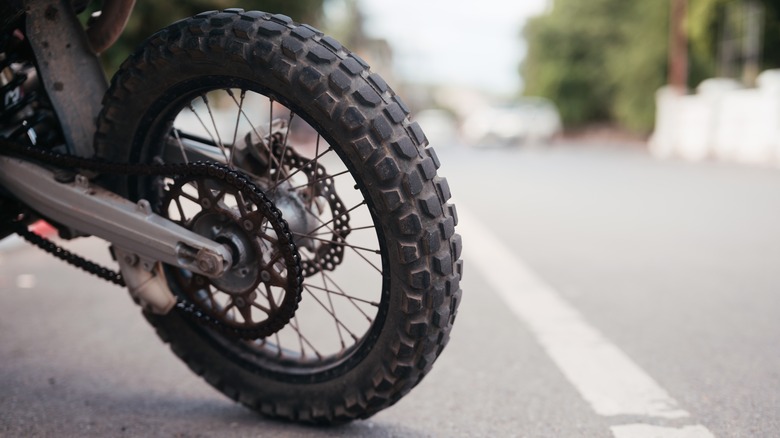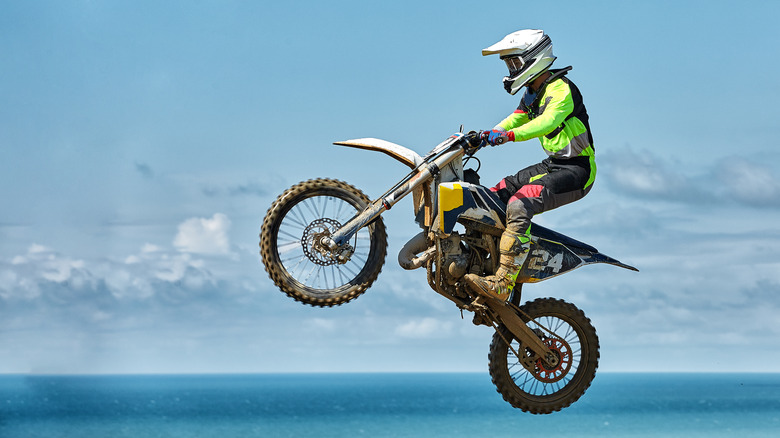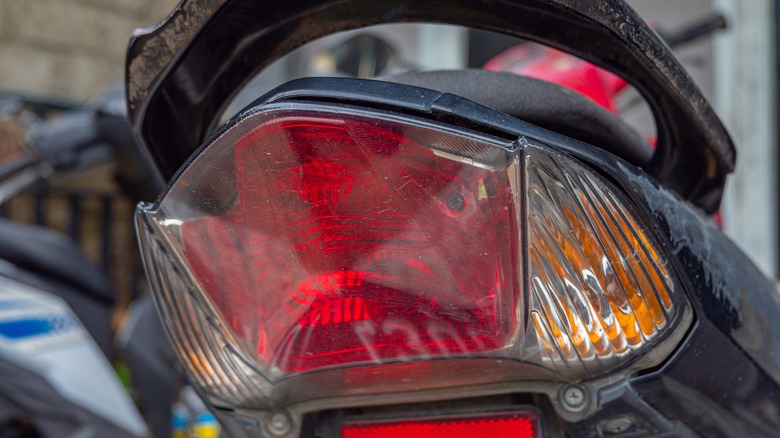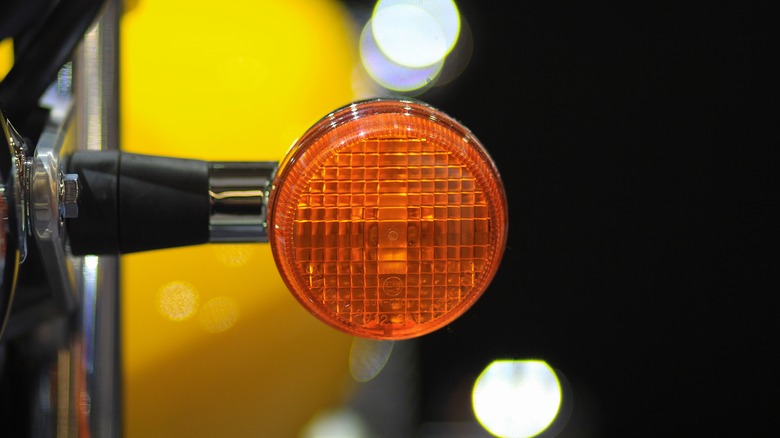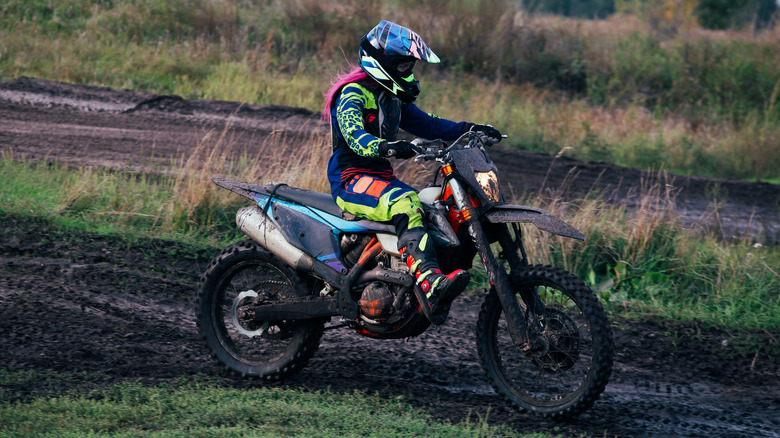5 Things You May Need To Change To Make Your Dirt Bike Street Legal
We may receive a commission on purchases made from links.
Off-road adventures on dirt bikes can be exhilarating and challenging. If you're wondering whether it's legal to drive your bike on standard roads and highways, the answer isn't so straightforward. Every state has specific laws surrounding motorcycles, and some states are more strict than others.
While there are a small number of street legal dirt bikes you can get, most dirt bikes require some additional modifications to make them street legal. This is because most classic models like the top-speed Honda 110 aren't designed for on-road use, and as such, you won't find features like headlights or turn signals that many states require. Thankfully, the equipment needed by most states isn't too expensive, and some options have more than one function.
Although specific laws are mentioned throughout this article, it's important to do your own research about the area you live in or plan to visit, as different states enforce different laws. If you're eager to get your dirt bike on the road but don't know where to start, here are the things you may need to make your dirt bike street legal.
You must have suitable tires
One of the key things that distinguishes dirt bikes from street motorcycles is the tires they use. To keep your bike street legal, there are many regulations outlined in the Federal Motor Vehicle Safety Standards, set out by the National Highway Traffic Safety Administration (NHTSA).
Firstly, all tires must show a Department of Transportation (DOT) symbol as well as a Tire Identification Number (TIN). These markings are placed next to one another on the sidewall of all street legal tires. If approved, you'll find the letters "DOT" (standing for the Department of Transportation) followed by four digits denoting the tire's production date.
Tires must also display at least three treadwear indicators. Treadwear marks show how much a tire has been worn, which is crucial for demonstrating stability and adequate grip on the road. Motorcycle tires must not have a tread depth of less than 1/32 inches. Lastly, all tires must demonstrate strength and endurance requirements after being subject to a high-speed performance test. These regulations apply at the federal level, however, it's important to check local laws for any extra tire requirements.
You may need a suitable headlight
Besides suitable tires, another change you'll likely need to make to grant your dirt bike street legal status is a suitable headlight. Laws vary between states, so it's important to check the specific regulations in your area. According to Florida law, every motorcycle and motor-driven cycle should have at least one but no more than two headlamps installed, and they should be installed between 24 and 54 inches from ground level. Headlamps should be always turned on – a law that's also enforced in New York. Some laws are also date-sensitive. For instance, Texas law requires all motorcycles manufactured after 1975 to be ridden with the headlight on.
One major drawback of installing headlights on your dirt bike is the amount of power they consume. While you might be lucky enough to own a dirt bike that generates more power than it needs to run, or that has a battery, this isn't always the case, and headlights are a power-hungry resource for your bike's electrical system. It's a good idea to install an LED headlight, which uses significantly less power than traditional halogen ones.
You may need a tail light with a working brake light
Another feature you probably need is a working tail light with a brake indicator. Tail lights are among the most critical safety features for any vehicle on the road, namely as they help other vehicles detect when you're reducing speed and improve your visibility at night.
In many US states, like California, motorcyclists are subject to the same rules as other vehicle users. So, it's a good idea to make sure you have a functioning tail light and brake function. According to New York law, tail lights must be visible from 300 feet and must be on whenever the vehicle is in use. The law in Florida requires the tail light to be positioned no more than 72 inches and no less than 20 inches from ground level.
As dirt bikes feature both front and rear brakes, you'll need to make sure the tail light is triggered by both brake mechanisms. This might mean installing a dual-switch setup, whereby one switch controls both the front and rear brakes. Another popular solution is called a banjo bolt switch. This mechanism relies on a ball bearing placed inside fluid that raises when the brakes are triggered. The final option to consider is a mechanical switch, which relies on physical movement from the brakes to activate the tail light. Tail lights use a similar amount of power to headlights, so you may wish to purchase an LED tail light to reduce power consumption. This is especially important if your dirt bike doesn't have a charging system.
Some states require mirrors
If you regularly use your dirt bike off-road, you may not be used to having mirrors. But when taking your dirt bike on the street, they quickly become a necessity. Especially in busy areas, mirrors become vital when making turns — they also allow you to check your surroundings without turning your head.
While many states offer a simple "yes" or "no" answer as to whether mirrors are required for motorcyclists, some offer a few specific regulations. California road laws state that no objects should hang from mirrors. According to Florida law, every vehicle requires a mirror, and it must provide a view of at least 200 feet behind the driver.
If your dirt bike isn't already equipped with mirrors, installing mirrors is relatively simple. However, it's important to check what type of mirrors your bike supports and any additional adapters you may need. If your bike doesn't support regular threaded mirrors, one workaround is to purchase a bar-end mirror. These popular types of mirrors clamp onto the handlebars, but you'll need an adapter to mount the mirrors successfully. As well as providing a wide-angle view, bar-end mirrors offer a sleek, unobtrusive look, maintaining the dirt bike's aesthetic while ensuring safety. No matter what type of mirror you're using, always check that the fitting is secure and ensure you have a clear view of your surroundings.
You may need turn signals
The requirement for turn signals also varies by state. New York law states, "one unit may be used to accomplish two or more lighting purposes", which is a great way to simplify your street legal checklist. According to Washington law, every vehicle manufactured after January 1 1960, must be equipped with electric turn signals. They must also strictly display an amber light (or white, if made before 1969), so it's important not to get too creative and install differently-colored turn signal lights.
While fitting electrical systems for turn signals and brake lights may feel daunting at first, turn signal kits help to remove stress, with many offering both turn signals and a brake light in one package. You can purchase turn signal kits for as little as $20 on Amazon, and many kits are color-coded for convenience. For example, yellow wires are used for turn signals, while a red wire connects the brake light. As well as convenient wiring, most kits utilize LED lights, which help to keep power use low. It's important to invest in turn signals that are bright enough to be noticed by other drivers.
There are some exceptions
There are several common laws that apply across different US states, for instance, getting your vehicle registered and insured. While following all the steps above will get your dirt bike street-ready, it's important to err on the side of caution and check local laws for state-specific regulations.
In Colorado, it's legally required to wear some form of eye protection while riding a motor vehicle, but helmets are not necessary for riders over the age of 18. In contrast, riders in California must wear a DOT-approved helmet by law, while face and eye protection is only recommended. If in doubt, it's safest to think of what rights automobile drivers require, as many states like Washington state that motorcyclists must follow the same rules as other motorists.
Before taking your dirt bike on the road, it's important to ensure your vehicle is registered, insured, and meets the correct mechanical standards. But this is only a first step — always check any laws governing your state to avoid getting into trouble. If you're looking for a hassle-free route, consider buying a dual-sport motorcycle, designed for both off-road and on-road usage and equipped with many street-legal features.
